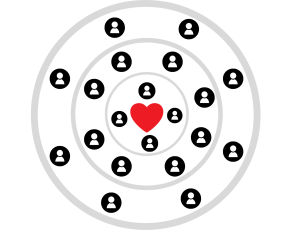People living with brain injury often feel isolated and alone. This may not be the case immediately after acquiring a brain injury: people drop by to visit or deliver food, there are lots of appointments to go to, and many call and texts asking for updates. You may find that you’re getting a lot of attention.
As time goes by, you may realize your social circle has decreased significantly from what it was before your injury. Offers of help may have dwindled, and you may be spending a lot of time by yourself. This may lead to feelings of loneliness.
People who are in recovery and living with a brain injury most often need the support of others – but it’s easy to think you are alone when you can’t picture your support network. However, it’s likely you have a whole group of people who can all play a part in building what we call your ‘circle of support’.
An easy way to think of your circle of support is to draw a circle you at the centre. Depending on your relationships, your circle of support will have several different levels, like the diagram below.
Inner circle
Your inner circle is usually those closest to you. This can include a spouse; a caregiver; children; parents; siblings; or close friends. These are the people you rely on the most and are more intimately involved in your recovery and care.
Middle circle
The next layer in your circle of care is the middle circle. These people are involved in your life, but perhaps not on a day-to-day basis. There may be a broad range of people here depending on your situation. Examples include:
- Aunts and uncles
- Grandparents
- Friends and their spouses or partners
- Neighbours
- Family friends
- Spiritual/faith-based supports
- Peers or classmates and their families
- Colleagues
- Part-time caregivers
- Rehabilitation therapists
Outer circle
The outer circle is made up of supports that may not be specific to you or used daily, but can still be relied on. These can include:
- Local business owners
- Community groups
- Community brain injury associations
- Community support organizations (for example: meal delivery)
Additional circle of support members
Your circle of support can also include more formal supports such as paid caregivers. Depending on where you are in your recovery, they may be in your middle circle (such as a case manager or personal support worker), or your outer circle (like a psychologist or your family doctor).
The following people could be considered formal supports:
- Doctor
- Nurse
- Physiotherapist
- Occupational therapist
- Social Worker
- Case Manager
- Speech-Language Pathologist
- Psychologist
- Chiropractor
- Community pharmacist
- Lawyer
Identify your circle of support
To help identify your support team, list all the people who have been in your life and have shown an interest in maintaining a relationship. Ask for help from the people who are close to you.
Identify areas where you need help
Having a list of the tasks or activities where you may need support is helpful to have on hand. Break the list up into different categories such as daily tasks, weekly tasks, or occasional tasks. For example:
- Help with getting to appointments
- A one-to-one visit over coffee
- Going outside for a walk
- Help with caring for a pet
You may often hear people say, “let me know if there is any way I can help,” and not take them up on the offer. You may find that people DO want to help; they just don’t know what you need. Do not be afraid to let them know how they can best help you.
The individual person and your relationship with them will determine where they fit in your circle of support. If they can help with smaller occasional things such as picking up your mail; dropping off a meal; driving you to appointments; or fixing a broken item in your home, they may belong in your outer circle. If the person can help with things that happen more often such as activities of daily living (ADLs), such as meal prep, cleaning, and personal care, they may belong in your inner circle.
Fostering your circle
It’s important for your circle to come together and understand how important they are to you. If you choose, you could introduce members of your circle to each other. By doing this, you are turning your circle of support into a true community.
You can also foster your circle by helping people understand what you need. Friends, family members, and caregivers may not realize it can be more difficult for you to communicate in noisy and busy environments of that you get tired/fatigued more easily.
There are a number of resources that may be helpful for those in your inner circle:
- Your local brain injury association may have support programs in place
- The University of Sydney has some free resources as part of their TBI Express program, designed to help people with brain injury and friends/family/caregivers with communication
We all need people who can support us and building a circle of care is one of the best ways to ensure that you get the support and compassion you need.
